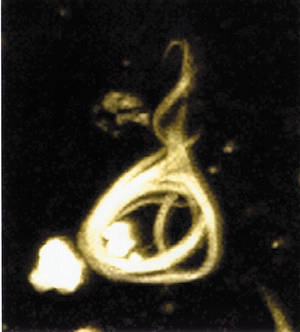Scientists at Columbia University in New York have figured out how one of the key proteins involved in Alzheimer's disease spreads through the brain.
Alzheimer's disease is a degenerative condition of the brain, caused when specific proteins in the nerve cells, known as beta amyloid and tau proteins, stop performing their proper roles in the nerve cells and instead clump into beta amyloid plaques or tau protein tangles. The tangles formed by the tau proteins were what the researchers at Columbia focussed on.
Post-mortem studies of human patients with Alzheimer's disease had suggested that an area of the brain just behind the ears, known as the entorhinal cortex, might be the starting point for the tauopathy - the degeneration caused by the abnormal tau proteins tangling up. So the researchers set out to engineer mice that would produce the abnormal human tau proteins in their entorhinal cortex, so that they could follow the progress of the disease.
They stained sections of the brains of these mice at different ages to look at where the tau proteins were, and whether they were normal or abnormal. And their results backed up the autopsy studies done in humans - it does appear that the tau proteins spread out from the entorhinal cortex, rather than it being a case of abnormal tau developing independently in separate parts of the brain.
One of the authors of the study, Karen Duff, believes there are several take home messages from their study, published in PLoS One, one of which is that we now have a reliable mouse model that can be used to study the disease further. Another is the rather unusual discovery about the movement of the tau proteins themselves...
'By the way that we looked at these mice we were able to say the tau had left one cell and moved to another cell and that's a radical piece of biology. It's suggestive of prion diseases like mad cow disease where you get a transmission of this abnormal protein through the brain.'
And when this abnormal tau spreads through the brain, it stimulates perfectly normal tau proteins in other cells to switch to being abnormal and start to tangle up. Karen was keen to stress that although these proteins move through the brain in this way, Alzheimer's isn't 'catching' - you can't 'catch' it from someone else.
And although Karen doesn't know exactly how the tangles move through the brain, the final take home message of the study was that it could point the way towards new therapies...
'At the earliest sages of Alzheimer's when the tangles are centred in the entorhinal cortex, when tau is seen there, patients tend not to be demented. So the idea is that if we can identify the disease at that stage and start giving some therapies, we might be able to trap the disease at that stage and stop people fom becoming demented. There are a couple of approaches, but the most targeted approach would be immunotherapy, where you use antibodies to latch onto the specific protein you want to remove and it removes it by a cellular clearance mechanism. You can develop those antibodies to the abnormal tau and perhaps catch the tau as it's outside the cell in the extracellular space.'
And the use of the immunotherapy that Karen mentioned is already being tested, so it represents a positive step forward towards treating Alzheimer's.










Comments
Add a comment